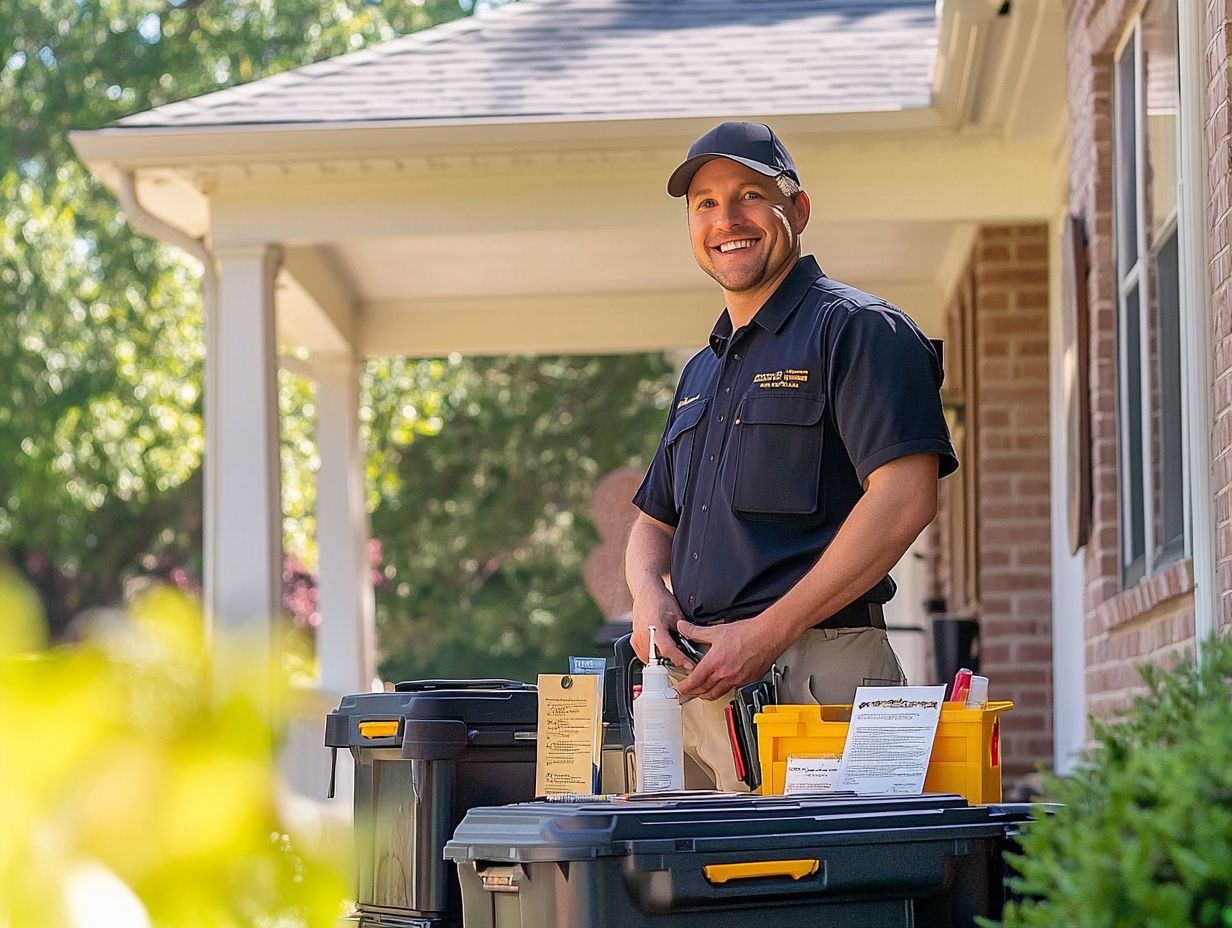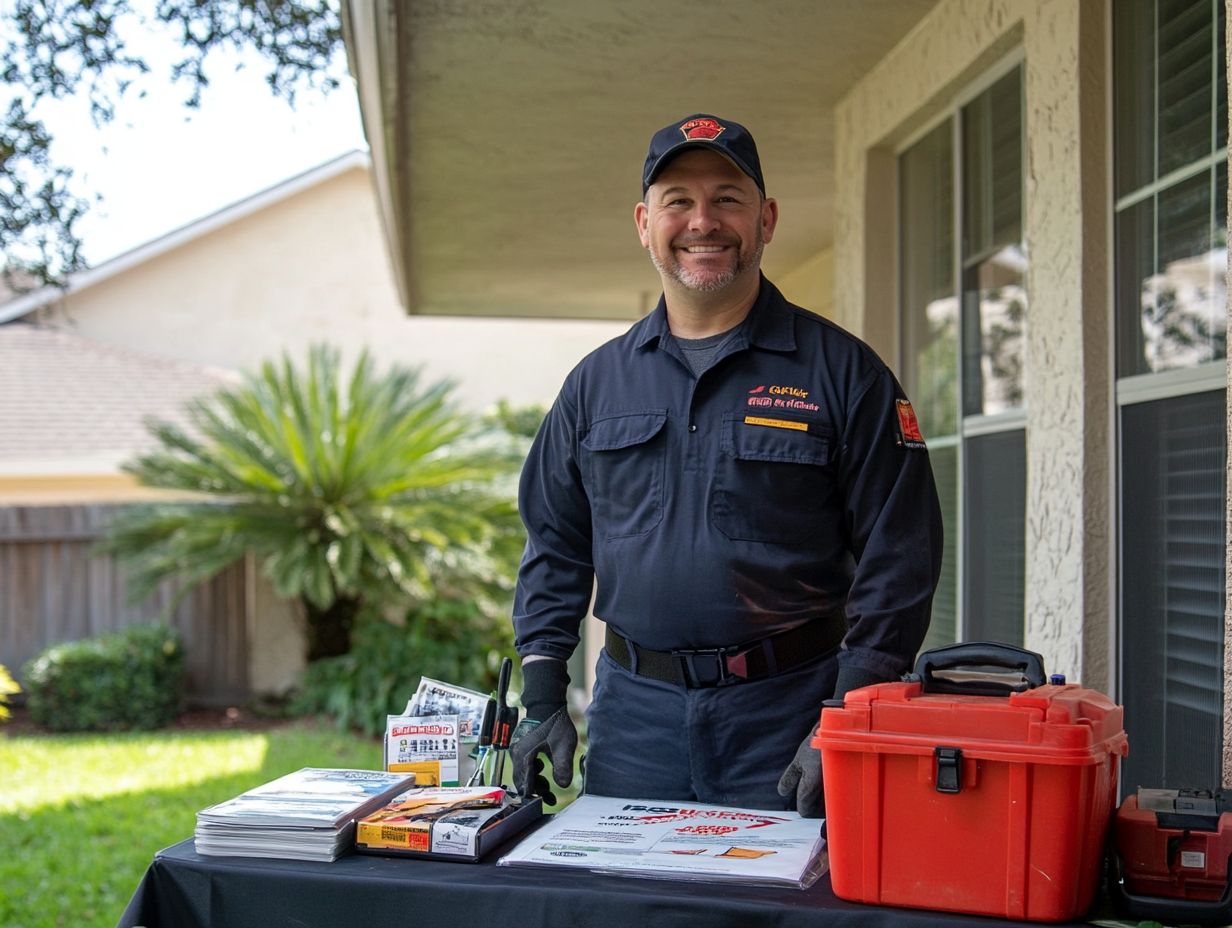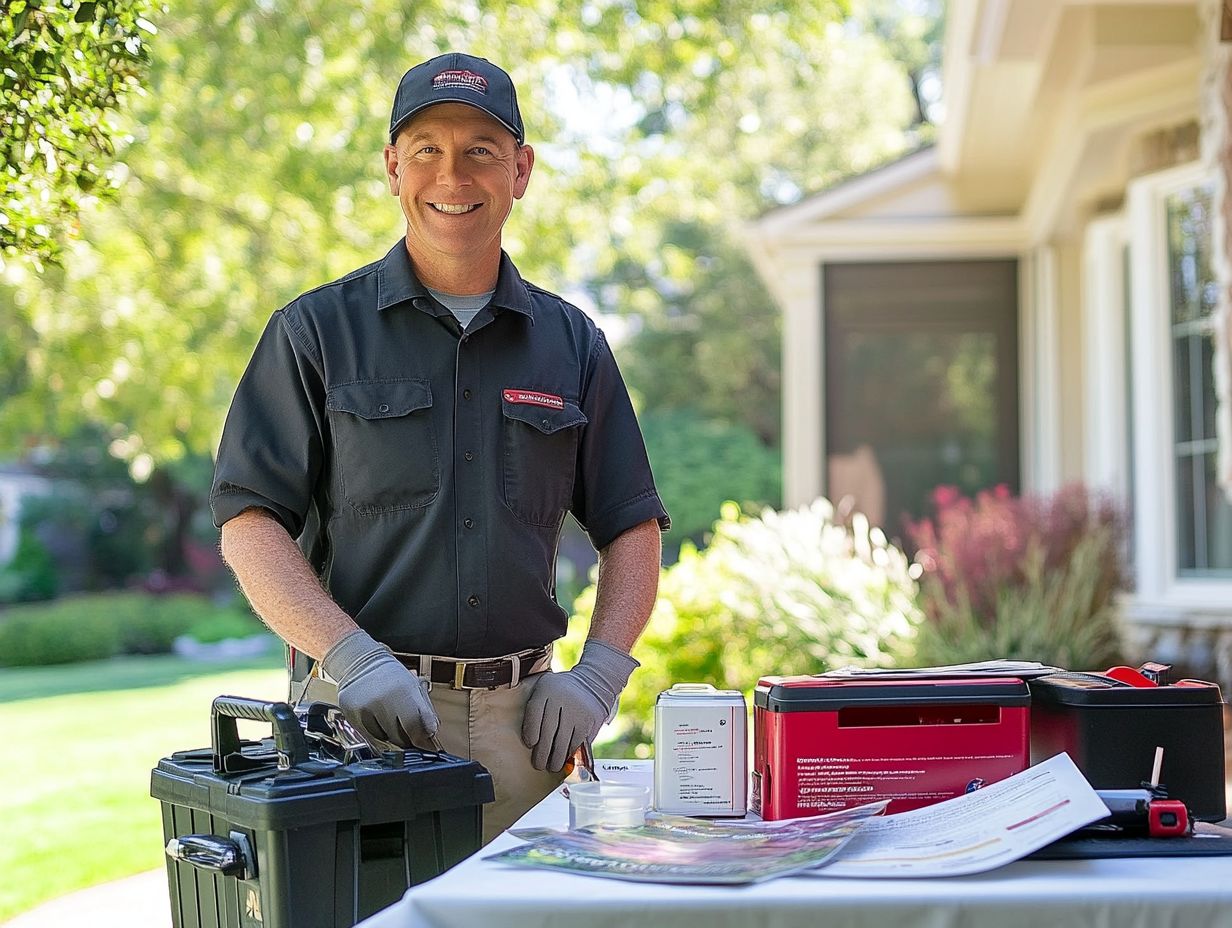In today’s competitive landscape, effective marketing is essential for your pest control services to thrive. With more and more homeowners looking for reliable solutions to their pest problems, it's crucial for you to understand how to reach and resonate with potential customers.
This article dives into the importance of marketing in the pest control industry, highlighting the benefits it can bring. You'll learn how to develop a targeted strategy that addresses your customers' pain points.
From identifying your unique selling proposition to measuring your marketing success, we’ll walk you through each step to make sure your services stand out in a crowded marketplace.
Why is Marketing Important for Pest Control Services?

Marketing is crucial for pest control services because it helps you build a solid online presence, connect with your target audience, and showcase what makes your offerings special.
In today's digital world, using a mix of marketing strategies—like SEO, social media, and local advertising—can really boost your brand visibility and bring in more customers. Plus, effective marketing does more than just generate leads; it helps keep your customers coming back and builds their loyalty, which is key to sustaining your business growth.
What are the Benefits of Marketing for Pest Control Services?
Marketing for pest control services comes with a ton of benefits, like boosting lead generation, improving your customer retention rates, and increasing your visibility in the local market. When you implement effective marketing strategies, you can really make the most of customer reviews and testimonials to build trust and credibility, which are key to promoting your services.
By understanding market analysis and audience targeting, you can allocate your advertising budget wisely and maximize your returns.
For example, a well-executed campaign that uses targeted online ads can significantly ramp up your lead generation, encouraging potential clients to book consultations. If you showcase positive customer reviews on your website and social media, you're not just enhancing your reputation; you're also influencing the decisions of prospective customers.
Plus, by keeping an eye on market trends, you can tweak your services or promotions to meet seasonal demands, which helps improve those customer retention rates.
Successful case studies show that companies putting a strategic advertising budget into social media marketing have experienced impressive growth in their client base, proving just how much potential there is for increased visibility and brand recognition in competitive markets.
Understanding Your Target Audience
Understanding your target audience is crucial when it comes to crafting effective marketing strategies for pest control services. By pinpointing your customer demographics and effectively segmenting the market, you can customize your marketing efforts to match the unique needs and preferences of your potential customers.
This approach not only boosts your outreach efforts but also makes sure your pest management solutions address the specific challenges your audience faces, leading to better service delivery in your area.
Who are Your Potential Customers?
Your potential customers for pest control services include homeowners, businesses, and property managers who are dealing with pest problems or looking for preventative measures. By understanding the specific demographics in your service area—like age, income level, and lifestyle choices—you can tailor your marketing efforts to really connect with these groups.
Building a strong online presence lets you reach out to potential customers and share valuable pest control information and solutions.
Segmentation of your customer base is key. For example, families with young children might prioritize eco-friendly pest control options, while commercial clients will be focused on keeping a pest-free environment for their employees and customers.
To engage with these groups effectively, you'll need targeted messaging and the right platforms. Think about using social media campaigns for younger homeowners or hosting informative webinars for property managers to really grab their attention.
By analyzing behavioral data and tapping into customer feedback, you can refine your approach and make sure you're meeting the specific needs and preferences of each demographic segment.
What are Their Pain Points and Needs?
Understanding your customers' pain points and needs is crucial for delivering effective pest control services. They often have common concerns, like worrying about the health risks pests pose, wanting quick and reliable solutions, and needing tips on how to prevent future infestations.
When you’re crafting a comprehensive marketing strategy, it’s important to emphasize trust and transparency in addressing these worries. Customers want to know that the methods you use are safe for their families and pets and that they can expect to see immediate results.
By showcasing testimonials and case studies, you can effectively highlight success stories that really resonate with potential clients. Providing informative articles, videos, and social media posts about pest prevention tips not only positions your service as an authority in the field but also helps build lasting relationships, significantly boosting overall customer satisfaction.
Developing a Marketing Strategy for Pest Control Services
Creating a strong marketing strategy for your pest control services is essential if you want to stand out in a crowded market. Start by figuring out what makes you unique—your unique selling proposition (USP).
Then, choose the right digital marketing channels and effective advertising methods to connect with your target audience. By tapping into SEO and content marketing, you can boost your online visibility, engage potential customers, and build long-term relationships that will drive your business growth.
1. Identifying Your Unique Selling Proposition (USP)

Identifying your unique selling proposition (USP) is crucial for making your pest control services stand out from the competition. A strong USP is your secret weapon for establishing a competitive edge, showcasing what makes your business special—whether that's top-notch service, budget-friendly pricing, or innovative pest control techniques. When you effectively promote your USP through your branding and marketing, you're not just attracting customers; you're building loyalty and encouraging referrals.
To figure out a compelling USP, start by analyzing what your competitors are doing well and where they might be falling short. Look at aspects like eco-friendly methods, quick response times, or specialized treatments for certain pests. For example, if you focus on organic pest control methods, you could really appeal to environmentally conscious customers, which is a booming market segment. On the flip side, if you offer 24/7 emergency services, you’ll stand out by tackling urgent pest problems without delay.
By paying attention to customer feedback and keeping an eye on market trends, you can refine your USP and clearly communicate your value proposition. This helps you create a memorable brand that truly resonates with your clients.
2. Choosing the Right Marketing Channels
Choosing the right marketing channels is key for you to effectively reach your target audience. Depending on your pest control services and customer demographics, you can tap into a variety of channels like social media, local advertising, Google Ads, and email marketing campaigns to make your outreach really impactful. By figuring out where your potential customers spend their time, you can optimize your marketing efforts and boost engagement.
For example, social media platforms like Facebook and Instagram are great for sharing engaging content—think tips on pest prevention and customer testimonials. This not only builds trust but also encourages community interaction. Local advertising, such as flyers or teaming up with neighborhood businesses, can enhance your visibility and credibility among residents.
Using Google Ads lets you run targeted advertising, making sure that people actively looking for pest control solutions see your services. And let’s not forget about email marketing; it’s a fantastic way to nurture leads and keep your services at the forefront of your audience’s mind. You can offer special promotions and informative newsletters that really resonate with them.
3. Creating a Budget for Marketing Expenses
Creating a solid budget for your marketing expenses is key to making sure your pest control services are getting the most bang for their buck. When you set up an advertising budget, you can strategically allocate resources across different channels, helping you optimize your return on investment (ROI) for all those promotional materials and campaigns. Regularly checking in on your spending and results lets you make smart decisions and tweak your marketing budget as needed.
In terms of managing your advertising budget effectively, it’s important to outline specific components like digital marketing, traditional advertising, content creation, and community outreach. Each of these areas needs careful tracking of expenses and performance metrics to see how well they’re doing. Plus, setting aside a little cash for testing new strategies can help you uncover untapped opportunities that really drive engagement.
Using tracking tools makes the review process a breeze, allowing you to make quick adjustments that align with changing market conditions or your business goals. By prioritizing financial planning, you can maximize your marketing potential while keeping your bottom line healthy.
4. Setting Measurable Goals and Objectives
Setting measurable goals and objectives is key to making your marketing strategy for pest control services a success. By defining clear targets for lead generation, conversion rates, and customer engagement, you can easily evaluate how well your marketing efforts are working and tweak things as needed. Having these metrics not only gives you direction but also lets you celebrate those wins and spot areas that need a little extra attention.
When you use the SMART framework, it’s super important to articulate specific goals that focus on different aspects of your pest control marketing. Instead of just aiming to increase leads, you might set a goal to boost your monthly lead count by 20% over the next quarter.
Making sure these objectives are measurable will help you assess conversion rates and understand how effectively your marketing strategies are resonating with potential customers. Achievable targets should strike a balance between being ambitious and realistic to keep your team motivated, while also aligning with your overall business goals. Plus, having a time-bound structure creates a sense of urgency and keeps everyone focused on hitting results within those set timeframes.
Implementing Your Marketing Plan
Implementing your marketing plan effectively means putting strategies into action that really connect with your target audience and boost customer engagement. This could involve creating content that grabs attention, using social media platforms for outreach, and rolling out promotional offers that catch the eye of potential customers.
By consistently delivering value and useful information, you can build trust and create lasting relationships with your audience.
1. Creating Engaging Content
Creating engaging content is key to a successful marketing strategy for pest control services. By using content marketing techniques like blog posts, videos, and customer education materials, you can effectively inform and attract your target audience. Engaging content not only showcases your expertise but also builds trust with potential customers.
Don’t forget to whip up some how-to guides that offer practical pest prevention tips—think natural repellents or safe home remedies. Infographics that visually illustrate common pest problems and their solutions can grab attention and are easy to share on social media, which helps amplify your reach.
Hosting webinars or Q&A sessions can be a game-changer, too. These events allow for real-time interaction, giving you the chance to address customer concerns while reinforcing your authority in the field. All these strategies not only educate potential clients but also create a sense of community and engagement, ultimately driving more leads to your business.
2. Utilizing Social Media Platforms

Using social media platforms is a fantastic way to boost customer engagement and build your brand in the pest control industry. By keeping an active presence on sites like Facebook, Instagram, and Twitter, you can share valuable content, customer testimonials, and promotions for your services. This not only establishes social proof and credibility but also helps you foster strong relationships with your customers, encouraging them to engage with your brand.
Targeted ads can really expand your reach and attract those specific demographics interested in pest control solutions. And don’t underestimate the power of visual content! Sharing before-and-after images or short educational videos can compellingly showcase the effectiveness of your services.
Engaging with your followers through polls or Q&A sessions also helps create a community around your brand, which deepens customer loyalty. By thoughtfully weaving these strategies together, you can elevate your online presence and turn those social media interactions into real business growth.
3. Networking and Partnering with Other Businesses
Networking and partnering with other businesses can really boost your client acquisition efforts in the pest control industry. By diving into trade shows, getting involved in your community, and forming strategic partnerships, you can widen your reach and attract potential customers. These collaborations not only open doors to new audiences but also help strengthen your brand’s reputation within the community.
Using social media platforms to connect with industry peers and clients can lead to informal yet valuable networking opportunities. Organizing or participating in workshops and informational sessions can help you establish authority in the sector as well.
By tapping into these various methods, you can build relationships that might lead to referrals and collaborative marketing strategies, turning casual connections into long-lasting partnerships. This proactive approach not only boosts your visibility at trade shows but also enhances your overall client acquisition process, ensuring you have a steady stream of business opportunities.
4. Offering Promotions and Discounts
Offering promotions and discounts can be a game-changer for pest control services when it comes to attracting new customers and keeping existing ones happy.
These strategies can really boost consumer interest and loyalty, especially when they tackle those seasonal pest problems, like dealing with pesky rodents in the winter or ant invasions in the summer. For example, if you run a "spring clean-up" offer, you could see a spike in service requests because homeowners are eager to protect their properties.
Plus, bundled service packages that give discounts on routine maintenance and pest inspections not only build customer loyalty but also keep homes safe throughout the year, leading to happier customers overall.
When people feel like they’re getting good value, they’re more likely to share their experiences, leading to positive referrals that enhance your reputation in the competitive pest control market.
Measuring and Analyzing Your Marketing Efforts
Measuring and analyzing your marketing efforts is crucial for figuring out how effective your pest control strategies really are. By using website analytics, keeping an eye on social media engagement, and gathering customer feedback, you can uncover valuable insights into conversion rates and what your customers prefer.
This data-driven approach will help you fine-tune your marketing tactics and get the best results possible.
1. Tracking Website Traffic and Conversions
Tracking your website traffic and conversions is crucial for understanding how well your pest control services are connecting with potential customers. By using robust analytics tools, you can measure the success of your SEO efforts and keep an eye on organic traffic levels, figuring out which sources are bringing in the most leads. This data will help you optimize your website and marketing strategies to boost those conversion rates.
To level up your tracking game, consider using tools like Google Analytics. It offers valuable insights into user behavior, traffic sources, and engagement metrics. Metrics like bounce rates, session durations, and conversion funnel analysis can give you important clues about how visitors are interacting with your services.
Heat mapping tools are also fantastic for visualizing user interactions on your site, showing you exactly where you might need to make some tweaks. Analyzing these metrics not only helps you tailor your content to what users want, but it also give the power tos you to refine your marketing tactics to maximize those conversions.
2. Monitoring Social Media Engagement
Monitoring your social media engagement is crucial to see how well your pest control services are hitting home with your audience. By checking out metrics like likes, shares, comments, and how well you're targeting your audience, you can get a sense of how effective your online presence is and what kind of customer feedback you're getting. This engagement gives you valuable insights into brand awareness and helps you shape your future marketing strategies.
Figuring out which posts spark the most interaction can show you what content your audience finds valuable or entertaining. For example, sharing infographics on pest prevention tips might get a lot more engagement than your usual advertising posts.
Using tools like Google Analytics or social media insights can help you track these metrics effectively. Plus, keeping an eye on customer feedback through surveys or analyzing comments lets you fine-tune your message and services.
In the end, taking a well-rounded approach to tracking engagement is key to boosting your brand's reputation and building a loyal customer base.
3. Gathering Customer Feedback and Reviews

Gathering customer feedback and reviews is crucial for building a positive online reputation for your pest control services. By actively encouraging testimonials and responding to feedback, you can gain valuable insights into customer satisfaction and the quality of your service. Showcasing those positive reviews in your marketing materials helps establish your credibility and attract new clients.
To effectively collect feedback, think about using multiple channels like surveys, social media, and direct follow-ups after the service. Creating a comfortable environment encourages honest opinions, making clients more likely to share their experiences.
Once you gather this feedback, use it to refine your services and highlight testimonials in your blogs, on your website, and across social platforms.
Spotlighting these positive experiences builds trust and shows that you take customer satisfaction seriously. And when it comes to negative reviews, addressing them thoughtfully can really demonstrate your commitment to improvement, further boosting your online reputation.
Frequently Asked Questions
How can I effectively market my pest control services?
To market your pest control services effectively, start by identifying your target audience and their specific needs. Then, utilize a combination of online and offline marketing strategies, such as SEO, social media, and direct mail campaigns. Make sure to also highlight your unique selling points and customer testimonials to attract potential clients.
What are some cost-effective ways to advertise my pest control services?
There are several cost-effective ways to advertise your pest control services, such as creating a strong online presence through social media and local directories, utilizing referral programs, and offering discounts for first-time customers. You can also partner with local businesses and attend community events to reach a wider audience.
Do I need a website to market my pest control services?
While having a website can greatly benefit your pest control business, it is not a requirement. However, having an online presence through a website or social media can help potential customers find and learn more about your services, and also provide a platform for you to showcase your expertise and customer reviews.
How can I differentiate my pest control services from competitors?
One way to differentiate your pest control services is by highlighting your unique selling points, such as eco-friendly solutions, 24/7 availability, or specialized treatments for specific pests. You can also showcase your expertise and experience in the industry through customer testimonials and case studies.
Is it important to have customer reviews for my pest control services?
Yes, customer reviews are crucial for marketing your pest control services. Positive reviews can build trust and credibility with potential customers, and also serve as social proof of your skills and effectiveness. Encourage satisfied customers to leave reviews on your website or social media pages.
Can I use social media to market my pest control services?
Absolutely! Social media is a great platform to showcase your pest control services, engage with potential customers, and reach a wider audience. Create engaging content, share customer reviews and before/after pictures, and utilize targeted advertising to attract potential clients.

